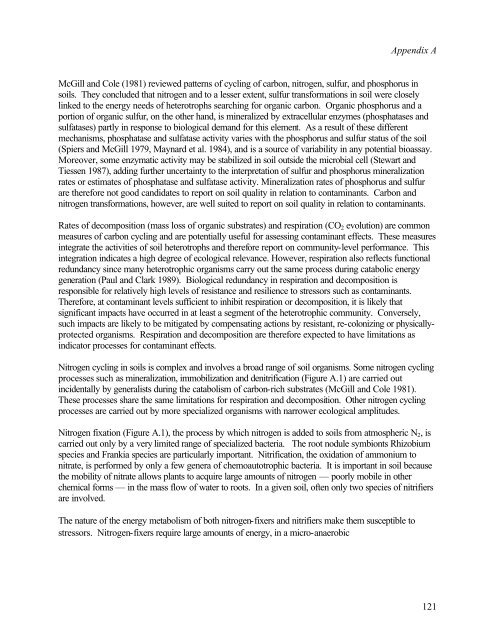Protocol for the Derivation of Environmental and Human ... - CCME
Protocol for the Derivation of Environmental and Human ... - CCME
Protocol for the Derivation of Environmental and Human ... - CCME
You also want an ePaper? Increase the reach of your titles
YUMPU automatically turns print PDFs into web optimized ePapers that Google loves.
Appendix A<br />
McGill <strong>and</strong> Cole (1981) reviewed patterns <strong>of</strong> cycling <strong>of</strong> carbon, nitrogen, sulfur, <strong>and</strong> phosphorus in<br />
soils. They concluded that nitrogen <strong>and</strong> to a lesser extent, sulfur trans<strong>for</strong>mations in soil were closely<br />
linked to <strong>the</strong> energy needs <strong>of</strong> heterotrophs searching <strong>for</strong> organic carbon. Organic phosphorus <strong>and</strong> a<br />
portion <strong>of</strong> organic sulfur, on <strong>the</strong> o<strong>the</strong>r h<strong>and</strong>, is mineralized by extracellular enzymes (phosphatases <strong>and</strong><br />
sulfatases) partly in response to biological dem<strong>and</strong> <strong>for</strong> this element. As a result <strong>of</strong> <strong>the</strong>se different<br />
mechanisms, phosphatase <strong>and</strong> sulfatase activity varies with <strong>the</strong> phosphorus <strong>and</strong> sulfur status <strong>of</strong> <strong>the</strong> soil<br />
(Spiers <strong>and</strong> McGill 1979, Maynard et al. 1984), <strong>and</strong> is a source <strong>of</strong> variability in any potential bioassay.<br />
Moreover, some enzymatic activity may be stabilized in soil outside <strong>the</strong> microbial cell (Stewart <strong>and</strong><br />
Tiessen 1987), adding fur<strong>the</strong>r uncertainty to <strong>the</strong> interpretation <strong>of</strong> sulfur <strong>and</strong> phosphorus mineralization<br />
rates or estimates <strong>of</strong> phosphatase <strong>and</strong> sulfatase activity. Mineralization rates <strong>of</strong> phosphorus <strong>and</strong> sulfur<br />
are <strong>the</strong>re<strong>for</strong>e not good c<strong>and</strong>idates to report on soil quality in relation to contaminants. Carbon <strong>and</strong><br />
nitrogen trans<strong>for</strong>mations, however, are well suited to report on soil quality in relation to contaminants.<br />
Rates <strong>of</strong> decomposition (mass loss <strong>of</strong> organic substrates) <strong>and</strong> respiration (CO 2 evolution) are common<br />
measures <strong>of</strong> carbon cycling <strong>and</strong> are potentially useful <strong>for</strong> assessing contaminant effects. These measures<br />
integrate <strong>the</strong> activities <strong>of</strong> soil heterotrophs <strong>and</strong> <strong>the</strong>re<strong>for</strong>e report on community-level per<strong>for</strong>mance. This<br />
integration indicates a high degree <strong>of</strong> ecological relevance. However, respiration also reflects functional<br />
redundancy since many heterotrophic organisms carry out <strong>the</strong> same process during catabolic energy<br />
generation (Paul <strong>and</strong> Clark 1989). Biological redundancy in respiration <strong>and</strong> decomposition is<br />
responsible <strong>for</strong> relatively high levels <strong>of</strong> resistance <strong>and</strong> resilience to stressors such as contaminants.<br />
There<strong>for</strong>e, at contaminant levels sufficient to inhibit respiration or decomposition, it is likely that<br />
significant impacts have occurred in at least a segment <strong>of</strong> <strong>the</strong> heterotrophic community. Conversely,<br />
such impacts are likely to be mitigated by compensating actions by resistant, re-colonizing or physicallyprotected<br />
organisms. Respiration <strong>and</strong> decomposition are <strong>the</strong>re<strong>for</strong>e expected to have limitations as<br />
indicator processes <strong>for</strong> contaminant effects.<br />
Nitrogen cycling in soils is complex <strong>and</strong> involves a broad range <strong>of</strong> soil organisms. Some nitrogen cycling<br />
processes such as mineralization, immobilization <strong>and</strong> denitrification (Figure A.1) are carried out<br />
incidentally by generalists during <strong>the</strong> catabolism <strong>of</strong> carbon-rich substrates (McGill <strong>and</strong> Cole 1981).<br />
These processes share <strong>the</strong> same limitations <strong>for</strong> respiration <strong>and</strong> decomposition. O<strong>the</strong>r nitrogen cycling<br />
processes are carried out by more specialized organisms with narrower ecological amplitudes.<br />
Nitrogen fixation (Figure A.1), <strong>the</strong> process by which nitrogen is added to soils from atmospheric N 2 , is<br />
carried out only by a very limited range <strong>of</strong> specialized bacteria. The root nodule symbionts Rhizobium<br />
species <strong>and</strong> Frankia species are particularly important. Nitrification, <strong>the</strong> oxidation <strong>of</strong> ammonium to<br />
nitrate, is per<strong>for</strong>med by only a few genera <strong>of</strong> chemoautotrophic bacteria. It is important in soil because<br />
<strong>the</strong> mobility <strong>of</strong> nitrate allows plants to acquire large amounts <strong>of</strong> nitrogen — poorly mobile in o<strong>the</strong>r<br />
chemical <strong>for</strong>ms — in <strong>the</strong> mass flow <strong>of</strong> water to roots. In a given soil, <strong>of</strong>ten only two species <strong>of</strong> nitrifiers<br />
are involved.<br />
The nature <strong>of</strong> <strong>the</strong> energy metabolism <strong>of</strong> both nitrogen-fixers <strong>and</strong> nitrifiers make <strong>the</strong>m susceptible to<br />
stressors. Nitrogen-fixers require large amounts <strong>of</strong> energy, in a micro-anaerobic<br />
121
















